More results...
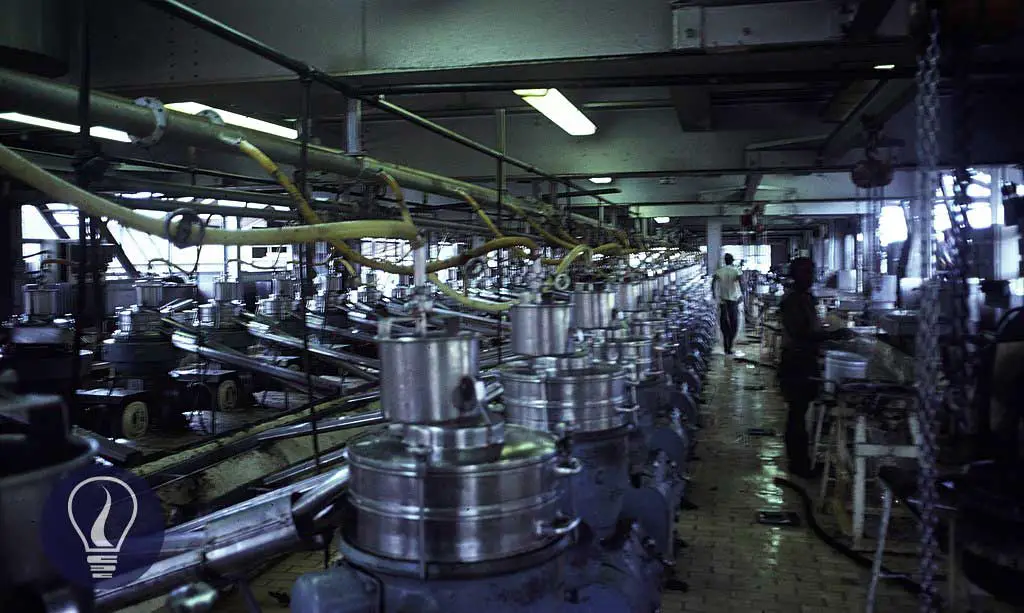

Preserved natural rubber latex is concentrated to reduce the water content and increase the rubber percentage in the latex. In fresh latex, the water percentage is about 65% and rubber content is around 30% by volume of the latex. After the preservation step, natural rubber latex is concentrated.
After concentration, the water level is decreased to 38%, and rubber content increases to 60% by the volume of the latex. To manufacture latex products, the latex should be in a liquid state. So, the water content of the latex should not be completely removed. Concentration is only done for natural rubber.
It is uneconomical to transport field latex over large distances. Most latex product manufacturing processes require high rubber content (TSC - Total Solid Content). Concentrated NR latex has a more uniform quality than field latex from which they are obtained. In some of the concentration processes, non-rubber substances are eliminated.

Latex cannot be directly heated because coagulation can happen instead of concentration. So, water in fresh latex is evaporated by a hot air stream in a rotating barrel. The rotating barrel is partially filled with latex and air steam passes through the barrel. Inside the rotating barrel, there is a hollow iron roller.
This roller is partially dipped in the latex. The main function of the hollow iron roller is homogenizing latex. Additionally, it prevents skin formation and destroys the froth. Increasing the surface area helps to increase the evaporation rate.
Ammonia is not suitable as a preservation agent for latex samples that are concentrated by the evaporation method. Because ammonia can also be evaporated when water evaporates. So, KOH is suitable for this type of concentrating method. The evaporation method is only used in small-scale productions.
In the creaming method, the density difference between rubber and water is used to remove excess water. To increase the density difference, creaming agents (Sodium alginate) are added to the preserved latex. Creaming agents increase the volume of rubber particles and therefore the density is decreased. for proper separation height of the container should be increased.
This method requires only simple equipment and the process is easy to operate. Power requirements are also negligible. The loss of rubber by going to the skim is very low. However this process is not widely used in large-scale production.
The major disadvantage of this process is time-consuming. It takes about 40 – 60 hours to separate rubber and water. Sometimes natural rubber interacts with creaming agents and is not separated into two phases. Sensitive variations occur in the field of latex and latex after creaming. The presence of residual creaming agents in the latex affects both the colloidal stability of the latex and the properties of the rubber film obtained from latex.
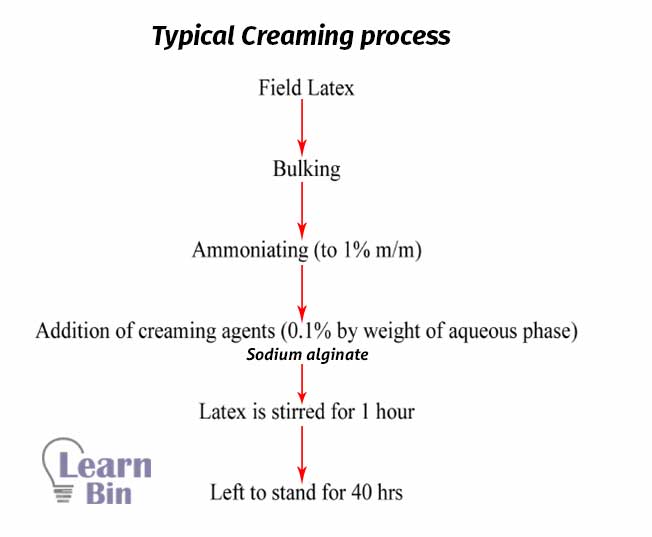
The centrifugation method is widely used in the latex industry. Before being taken to the centrifuge machine, preserved latex is tested by doing some quality tests. Dry rubber content -DRC, Ammonia content, Volatile fatty acid (VFA) number, and Mg2+ ion content are measured.
After doing quality tests, latex is sieved and stored in a settling tank. To remove the Mg2+ ion, Diammonium hydrogen phosphate (15% DAHP) is added to the latex and stirred well. The latex is left for 24 hours to precipitate Magnesium sludge (MgNH4PO4). Then the Magnesium sludge is removed, and the latex is taken to the centrifuge machine.

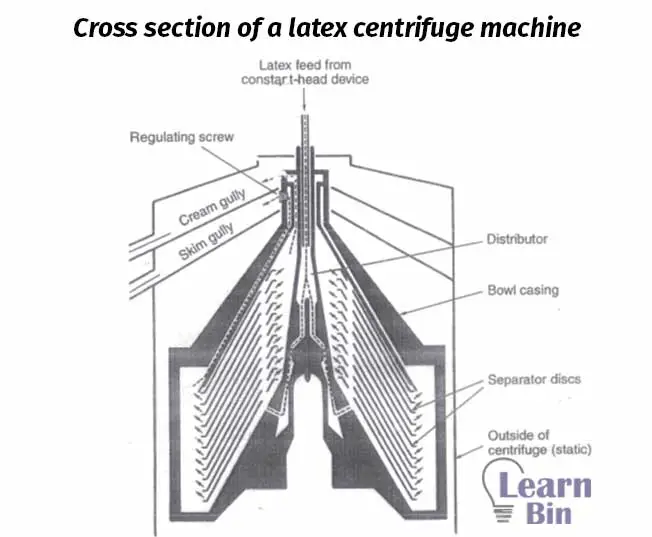
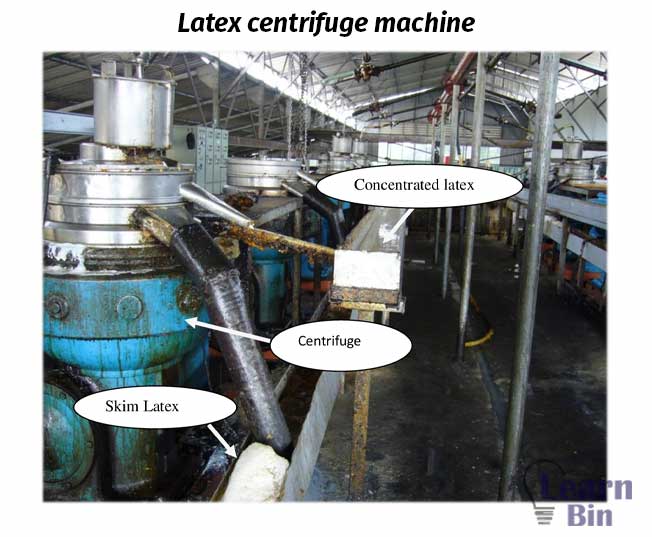
| Property | High ammonia concentrated latex | Low ammonia concentrated latex |
| TSC % by weight (minimum) | 61.5 | 67.5 |
| DRC% (minimum) | 60 | 60 |
| Non-rubber solids (minimum) | 2 | 2 |
| Alkalinity as grams of NH3 per 100 grams of the aqueous phase | 0.6 (minimum) | 0.3 (maximum) |
| MST (minimum) | 540s | 540s |
| VFA Number (maximum) | 0.2 | 0.2 |
| KOH Number (maximum) (Total fatty acid) | 1.0 | 1.0 |
Various tests are performed to test the quality of latex. Fresh latex is collected from the rubber tree by tapping the tree trunk. At the collecting, stage preservation is done. After collecting the latex, dry rubber content (DRC) and the weight of the latex are measured.
The density of the preserved natural rubber latex is measured by using “Metrolact” which is a hydrometer. Density gives a rough estimate of dry rubber content (DRC)
Total solid content is the weight percentage of both rubber and non-rubber substances in latex. A latex sample is weighed and then dried at 100 ℃ for 2 hours or at 70 ℃ for 16 hours. The weight of the dried sample is measured.
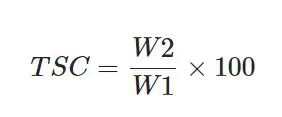
W1 = weight of the initial sample
W2 = weight of the dried sample
Defined as the percentage by weight of rubber presence in a sample of latex. A known weight of latex is coagulated with 2% acetic acid to separate the rubber from non-rubber substances. If the serum is milky about 5ml ethanol is added. The coagulum is collected as one lump and washed with water. The coagulum is pressed into a sheet to remove excess water. The process of washing and pressing is repeated 2-3 times and it is dried in an oven at 70 ℃ for 14 hours.

W1 = weight of the initial sample
W2 = weight of the dried sample
Alkalinity is defined as the percentage by weight of ammonia present in a sample of latex. The volumetric titration method is used to determine the alkalinity. A standard solution of dilute hydrochloric acid is used as the titrant.

V= volume of acid used in titration (in ml)
N= normality of the acid
m= mass of the test sample (in grams)
The VFA no of latex is the no of grams of KOH equivalent to the volatile fatty acids in latex containing 100g of total solids content. VFA number is an indication of good preservation. Only checking ammonia content is not enough to predict preservation. Because it gives only the amount of ammonia present in latex.
By checking the percentage of fatty acid anions present in the latex, we can predict bacteria activity in the latex. If the anion content is high, that means the bacteria growth is high. Therefore, the VFA number is a critical parameter.
KOH no is defined as the no of grams of KOH equivalent to the anions present as ammonium salts in a sample of latex containing 100g of total solids. The test method used here is pH titration of latex with a standard KOH solution. The steady increase in KOH number indicates the growth in the concentration of ammonium soaps.
In this test, latex is stirred at a high speed and the time required to initiate visible flocculation (micro coagulation) is regarded as a measure of its mechanical stability. Addition of fatty acid soaps courses the MST of the latex to be increased. It has been found that the optimum chain length for saturated fatty acid soap is in the region 10-12.
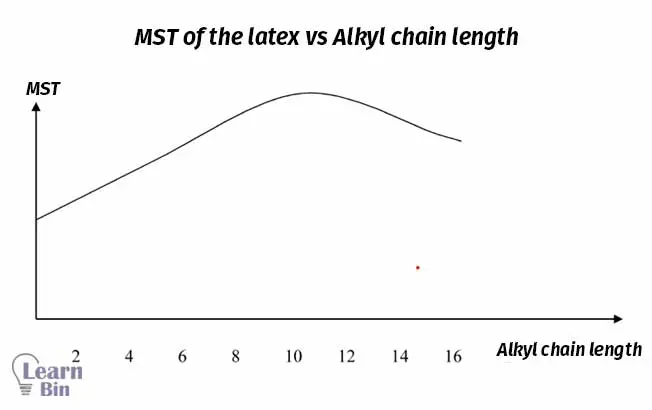
The viscosity is determined using a viscometer which measures the torque produced on a specified spindle rotating at a constant speed and low rate of sheer while immersed to a known depth in the latex. A “Brook field” viscometer is used for this purpose.
The stability of latex has been stored for any period with a balance of two factors. Which are VFA Number and lipid hydrolysis. VFA formation tends to reduce the stability of the latex. Hydrolysis of lipids tends to increase the stability of latex by forming nonvolatile fatty acids. Some reported results on the effect of the storage period on the stability of NRL are given below.
| Age (Days) | MST (s) | KOH number | VFA number |
| 1 | 37 | 0.35 | 0.010 |
| 7 | 141 | 0.41 | 0.011 |
| 30 | 639 | 0.46 | 0.011 |
| 90 | 869 | 0.50 | 0.012 |
| 180 | 883 | 0.54 | 0.013 |

www.intechopen.com - Rapid Evaluation of the Properties of Natural Rubber Latex and Its Products Using Near-Infrared Spectroscopy
By Panmanas Sirisomboon and Chin Hock Lim
The cover image was designed using a photo by Fred van der Kraaij, available in Wiki | This file is licensed under the Creative Commons Attribution-Share Alike 4.0 International.
Figure 05: Maulina, S. (2014). Enhancement of eco-efficiency through life cycle assessment in natural rubber latex concentrate processing / Seri Maulina.
Centrifuge rubber products costs more than other rubber products; then, how would be become lesser rate than other rubber products? Thanks